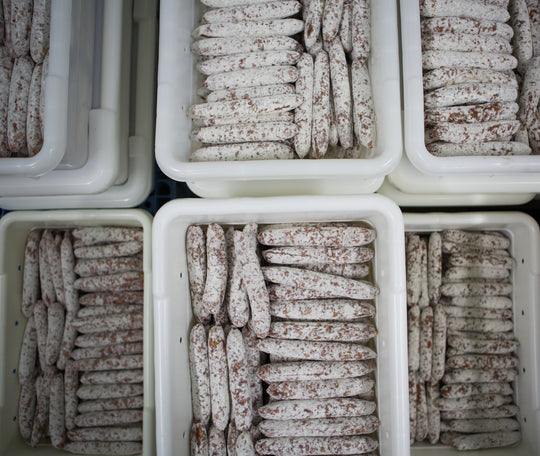Mold!
Why Mold on Salami is Good for You

Hey everybody! My name is Paul Oppliger, and I am the QA/QC Manager here at
Olympia Provisions. Day in and day out, I make sure that the products we produce and send to you are as close to perfect as possible. I also help to resolve the problems and feedback we hear from you, to ensure that we are making the most delicious products we can. One of the most frequently asked questions we get is "why is there mold on my salami?" This is a question I answer almost every day, so to help you all understand, I am going to give you a look inside my world and answer some questions you might have!

What is that powdery stuff?
Last time you received an Olympia Provisions salami you probably noticed that the outside was coated with some white, blue, gray or green fuzzy stuff. Yes, that is mold! But not "that" kind of mold. The mold we use, penicillium nalgiovense, is integral to our salami. Like the mold on a fine cheese, p. nalgionvense gives our salami a special character. We intentionally use mold on the outside of our salami as part of our curing and fermentation process. It's unique to our production and is nothing you should be afraid of. It's something we love and that sets us apart. Unlike some salami makers, we keep our molds, rather than brushing them off or mimicking them with milk or rice powder.

Why use mold?
The first reason we use mold is to protect the salami from any competing molds or bacteria growth during the drying process. Inoculating our salamis with penicillium nalgiovense (good mold) drives off any potential bad mold that might exist in the environment. Our mold army vanquishes any potential undesirables through sheer numbers! Another key function is to regulate the drying of the salami. The mold keeps the surface of the salami from drying out too quickly or slowly, making for a ready-to-eat, high-quality, finished product. Finally, the mold on the exterior of our salami contributes to the overall flavor by mellowing out the acidity produced during fermentation. We could cure our salami differently and not use mold, but it would drastically change our product (it wouldn't taste as great as it does).
My salami doesn't look like the others I ordered!
Milk and rice powders are always consistent and white, but they aren't natural or wild like what we utilize. Although we use the same species every time we inoculate our salami, we can't say that it is going to act the same way each time. Part of creating a natural product means we allow nature to unfold without too much interference. Each year, we watch it change with temperature, humidity and the evolving nature of the mold. We control it as closely as we can, and try to monitor it if things get a bit too wild, but we still find that there is natural variation. Which is why there is such a range in color and appearance, from white to green to shades of dark gray and black. The black mold especially can seem off-putting, but it isn't unsafe to consume, and again, that's part of the wonder of dealing with a natural product.

How do I store my salami?
Although we're talking specifically about mold, the mold and salami are one beast. What's good for the mold is good for the salami. The important thing to remember about salami is that an exchange of oxygen is vital, the molds need air to keep growing. When they are no longer getting oxygen, they die off. At home, I loosely wrap my salami in its paper, then place it in an unsealed Ziplock bag. Store it in the crisper drawer of your home refrigerator, so it's not cut off from airflow and remains cold but not too cool. In this manner your salami can last for days or even weeks. The molds are delicious, are meant to add flavor and totally safe to eat. I always say that it's up to individual taste, but in no way would consuming it be harmful, and if desired, you can easily peel the casing.

